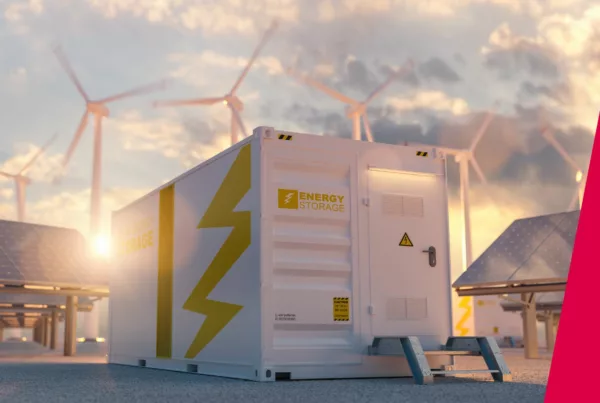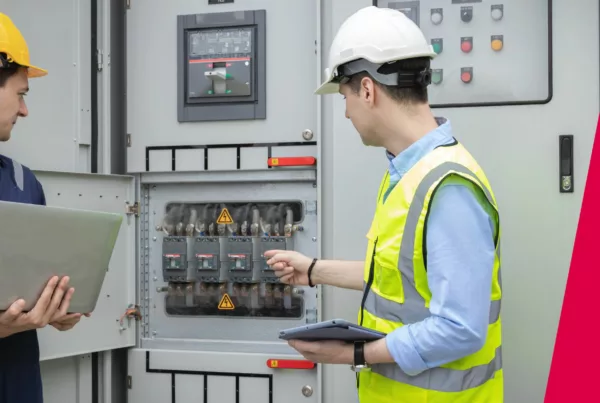If you are connecting energy-generating assets, such as solar PV, or energy storage to the UK National grid that is over 16A (3.68kW), then you will be familiar with UK G99 or Engineering Regulation (EREC) G99. Here, we expand on UK G99 and its relevance for renewable energy generators and battery operators, demystify commonly used terms, and explain our role at EpiSensor in supporting compliance.
Firstly, What is UK G99?
UK G99 is a technical standard that applies to the connection of power-generating assets to the electricity distribution networks in the UK. This standard is part of the Distribution Code and sets out the requirements for generators with a capacity exceeding 16A per phase. The purpose of UK G99 is to ensure the safe and stable operation of the power grid as it integrates an increasing number of distributed energy resources (DERs), including solar PV systems, wind turbines, and battery energy storage systems.

Understanding UK G99
UK G99 was introduced in April 2019 as part of a significant update to the grid connection requirements in the UK. It replaced the previous G59 standard and is aligned with the European Network Code Requirements for Generators (RfG). The standard applies to both synchronous power-generating modules and power park modules, covering a wide range of generation technologies.
How is G99 Relevant for Renewable Generators and Battery Operators?
As the grid incorporates more diverse and distributed energy resources, standardised connection requirements become increasingly important. UK G99 is particularly relevant for operators of renewable energy systems and battery storage facilities, ensuring they meet grid safety and stability standards. Solar PV installations, wind farms, and battery energy storage systems all fall under the remit of UK G99, provided they meet the capacity thresholds.
For solar PV and other renewable generators, UK G99 ensures that these systems can integrate seamlessly with the grid, providing stable power output and responding appropriately to grid events. Battery operators must also comply with UK G99, as energy storage systems play a crucial role in grid balancing and frequency regulation.
Key Features of UK G99
1. Categorisation of Generators: UK G99 classifies generators into four types (A, B, C, and D) based on their capacity and connection voltage. This categorisation determines the specific requirements each generator must meet.
The categories are defined as follows:
- Type A: 0.8 kW to 1 MW and connected at less than 110 kV
- Type B: 1 MW to 10 MW and connected at less than 110 kV
- Type C: 10 MW to 50 MW and connected at less than 110 kV
- Type D: 50 MW and above or connected at 110 kV or above
These categories ensure that the requirements are proportionate to the generator’s size and potential impact on the grid.
2. Fault Ride Through: This standard specifies the ability of generators to remain connected and operational during network disturbances, enhancing grid stability.
3. Frequency Response: UK G99 outlines the required frequency response capabilities of generators, including both over-frequency and under-frequency scenarios. This is particularly important for maintaining grid stability with increasing levels of renewable generation.
4. Voltage Control: This standard defines voltage control requirements for different generator types, ensuring appropriate voltage regulation within the network.
5. Protection Setting: Specifies protection settings for various scenarios, including loss of mains, over/under voltage, and over/under frequency.
6. Power Quality: Specific requirements for harmonic emissions, flicker, and other power quality parameters.
7. Compliance Process: UK G99 details the process for demonstrating compliance, including simulation studies and on-site testing requirements.
Ready to navigate UK G99 requirements and improve your grid integration?
Discover how EpiSensor’s IoT technology helps renewable operators and battery systems providers meet frequency response and voltage control standards effortlessly.
Frequency Response in UK G99
Frequency response is a critical aspect of UK G99 and is particularly relevant for renewable generators and battery storage systems. As the grid incorporates more variable renewable energy sources, maintaining a stable grid frequency becomes increasingly challenging. UK G99 sets out specific requirements for frequency response to address this challenge.
Types of Frequency Response
- Limited Frequency Sensitive Mode – Overfrequency (LFSM-O)**: All generator types (A, B, C, and D) must be capable of reducing active power output in response to a rise in grid frequency above a certain threshold (typically 50.4 Hz).
- Limited Frequency Sensitive Mode – Underfrequency (LFSM-U)**: Required for Type C and D generators, this mode involves increasing active power output in response to a fall in grid frequency below a certain threshold.
- Frequency Sensitive Mode (FSM): Type C and D generators must be capable of operating in FSM, which involves continuous modulation of active power output in response to frequency changes.
- Rapid Frequency Response: Some generators, particularly battery storage systems, may be required to provide rapid frequency response, reacting to frequency changes within milliseconds.
Frequency Response Requirements Under UK G99
The specific frequency response requirements vary depending on the generator type:
- Type A generators must be capable of LFSM-O operation.
- Type B generators must meet Type A requirements and may have additional frequency response capabilities as specified by the relevant system operator.
- Type C and D generators must be capable of LFSM-O, LFSM-U, and FSM operation, with more stringent performance requirements.
Importance of Frequency Response
Effective frequency response is crucial for maintaining grid stability, especially as the energy mix shifts towards more renewable sources. Solar PV systems, wind turbines, and battery storage facilities all play important roles in providing frequency response:
- Solar PV and wind generators can modulate their output to respond to over-frequency events.
- Battery storage systems can provide both up and down regulation, responding rapidly to frequency deviations in either direction.
- Aggregated small-scale generators, including residential solar PV systems, can collectively provide significant frequency response capabilities.

Distributed Energy Resources (DER) and UK G99
Distributed Energy Resources (DER) are increasingly important in the context of UK G99. DERs include a wide range of technologies such as solar PV systems, small wind turbines, battery storage, electric vehicles, and demand response systems. These resources are typically connected to the distribution network rather than the transmission network.
UK G99 plays a crucial role in integrating DERs into the grid by:
- Standardising Connection Requirements: UK G99 provides a clear framework for connecting DERs to the grid, ensuring consistency across different types of generators and locations.
- Enabling Grid Services: By specifying requirements for frequency response, voltage control, and fault ride-through, UK G99 enables DERs to provide valuable services to the grid.
- Facilitating the Smart Grid: The standard supports the development of a smarter, more flexible grid that can accommodate bidirectional power flows and dynamic control of distributed resources.
- Ensuring System Stability: As the adoption of DERs increases, UK G99 helps maintain overall system stability by ensuring that these resources respond appropriately to grid events.
- Supporting the Energy Transition: By providing a framework for the integration of renewable and low-carbon technologies, UK G99 supports the UK’s transition to a more sustainable energy system.
EpiSensor’s Role in UK G99 Compliance
EpiSensor’s IoT-based energy monitoring and management solutions can play a significant role in helping power generators meet UK G99 requirements, particularly in the areas of frequency response and overall grid integration.
EpiSensor’s advanced IoT infrastructure offers:
- Real-time Monitoring: EpiSensor’s hardware sensors and software platforms enable real-time monitoring of generator output, facilitating compliance with frequency and voltage control requirements. This is particularly important for renewable generators and battery storage systems that need to respond quickly to grid conditions. With response times of under 80ms and systems that are proven in challenging environments, you can rely on the instantaneous reaction power of EpiSensor technology.
- Data Analytics: The EpiSensor Platform provides advanced analytics capabilities, allowing generators to analyse their performance against UK G99 standards and identify potential issues. This can be especially useful for optimising frequency response strategies.
- Remote Management: With EpiSensor’s remote management features, operators can adjust generator settings to maintain compliance with UK G99 requirements, even in distributed energy scenarios. This is crucial for managing large fleets of renewable generators or battery systems.
- Integration with Smart Grid Systems: EpiSensor’s solutions can integrate with wider smart grid systems, supporting the overall goals of UK G99 in enhancing grid stability and facilitating the energy transition.
- Compliance Reporting: The data collected and analysed by EpiSensor’s systems can be used to generate compliance reports, simplifying the process of demonstrating adherence to UK G99 standards.
- Demand Response Capabilities: EpiSensor’s ZDR (Demand Response Controller) can be particularly relevant for frequency response applications. The ZDR is designed to facilitate participation in demand response programmes, which can help balance the grid and support compliance with UK G99 requirements. By enabling rapid load reduction or increase in response to grid signals, the ZDR can contribute to frequency regulation and grid stability.
- Load Control and Monitoring: The ZDR provides real-time monitoring and control of electrical loads, allowing for precise management of energy consumption. This capability can be leveraged to adjust power usage in response to grid frequency events, supporting the frequency response requirements of UK G99.
- Aggregation of Distributed Energy Resources: EpiSensor’s platform can aggregate data from multiple distributed energy resources, enabling coordinated frequency response across a fleet of generators and controllable loads. This is particularly valuable for virtual power plant operations and for meeting the more stringent requirements of Type C and D generators under UK G99.
- Performance Analysis: By collecting high-resolution data on generator and load performance during frequency events, EpiSensor’s systems can help operators fine-tune their frequency response strategies and demonstrate compliance with UK G99 requirements.
- Flexible Integration: The ZDR’s ability to integrate with various communication protocols and control systems makes it a versatile tool for implementing demand response strategies that align with UK G99 requirements.

Paving the way for the UK’s Energy Future
By leveraging EpiSensor’s comprehensive energy monitoring, management, and demand response solutions, power generators, including renewable energy systems and battery operators, can more easily navigate the complexities of UK G99 compliance while contributing to the development of a more sustainable and resilient power grid.
EpiSensor’s monitoring and control solutions are particularly well-suited to managing DERs in compliance with UK G99. The ability to aggregate data from multiple sources, provide real-time insights, and enable rapid response to grid conditions makes EpiSensor’s technology valuable for DER operators seeking to meet UK G99 requirements.
As the UK moves towards its net-zero carbon emissions target, the role of standards like UK G99 and technologies that support compliance will only grow in importance. By embracing these standards and leveraging advanced monitoring, control, and demand response solutions, the energy industry can build a more resilient, sustainable, and efficient power system for the future.
Are your renewable energy systems and battery storage facilities meeting UK G99 standards?
Learn how EpiSensor’s real-time monitoring and demand response solutions can streamline compliance and enhance grid stability.



